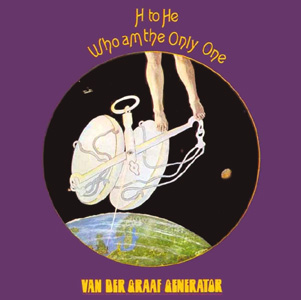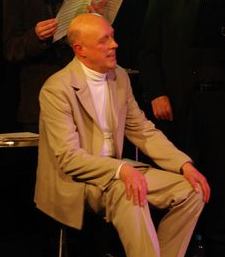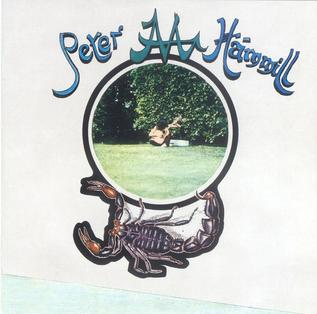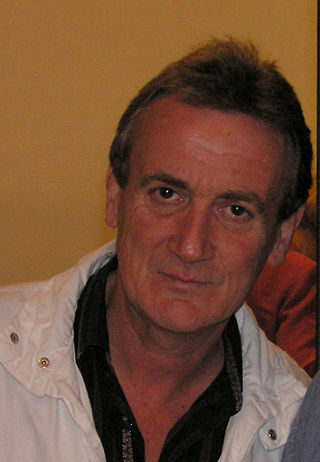Related Research Articles

Peter Joseph Andrew Hammill is an English musician and recording artist. He was a founder member of the progressive rock band Van der Graaf Generator. Best known as a singer-songwriter, he also plays guitar and piano and produces his own recordings and occasionally those of other artists. In 2012, he was recognised with the Visionary award at the first Progressive Music Awards.

David Nicholas George Jackson, nicknamed Jaxon, is an English progressive rock saxophonist, flautist, and composer. He is best known for his work with the band Van der Graaf Generator and his work in Music and Disability. He has also worked with Peter Gabriel, Keith Tippett, Osanna, Judge Smith, David Cross and others.

Guy Randolph Evans is an English drummer and a member of the progressive rock band Van der Graaf Generator.

Pawn Hearts is the fourth album by English progressive rock band Van der Graaf Generator, released in October 1971 on Charisma Records. The original album features just three tracks, including the side-long suite "A Plague of Lighthouse Keepers". The album was not commercially successful in the UK, but reached number one in Italy. It has since seen retrospective critical praise and was reissued on CD in 2005 with extra material.

H to He, Who Am the Only One is the third album by the British progressive rock band Van der Graaf Generator. It was released in 1970 on Charisma Records.

The Least We Can Do Is Wave to Each Other is the second album by the British progressive rock band Van der Graaf Generator, released in February 1970 on Charisma Records. It was the group's first album to be released in the UK and the only one to chart in the top 50 in that country.

Paul Whitehead is a British painter and graphic artist known for his surrealistic album covers for artists on the Charisma Records label in the 1970s, such as Genesis and Van der Graaf Generator.

Christopher John Judge Smith, is an English songwriter, author, composer and performer, and a founder member of progressive rock band Van der Graaf Generator. Initially working under the name Chris Judge Smith, he has been known simply as Judge Smith since 1994. After Van der Graaf Generator, he has written songs, stage musicals and operas, and from the early 1990s on he has released a number of solo CDs, including three "Songstories".

Tony Stratton Smith was an English rock music manager, and entrepreneur. He founded the London-based record label Charisma Records in 1969 and managed rock groups such as the Nice, Van der Graaf Generator and Genesis.

The Quiet Zone/The Pleasure Dome is the eighth album by British progressive rock band Van der Graaf Generator. Released in 1977, it was their last studio album before their 2005 reunion. The album features a more energetic, new wave sound than its three immediate predecessors, anticipating singer and songwriter Peter Hammill's late 1970s solo work.

Hugh Robert Banton is a British musician and electronic organ builder, most widely known for playing organ and keyboards with the group Van der Graaf Generator.

The Aerosol Grey Machine is the debut studio album by English progressive rock band Van der Graaf Generator. It was first released in the United States in 1969 by Mercury Records.

Chameleon in the Shadow of the Night is the second solo album by British singer-songwriter Peter Hammill. It followed in the aftermath of the breakup of Hammill's band Van der Graaf Generator, and other ex-members of Van der Graaf Generator perform on the album.

Van der Graaf Generator are an English progressive rock band, formed in 1967 in Manchester by singer-songwriters Peter Hammill and Chris Judge Smith and the first act signed by Charisma Records. They did not experience much commercial success in the UK, but became popular in Italy during the 1970s. In 2005 the band reformed, and are still musically active with a line-up of Hammill, organist Hugh Banton and drummer Guy Evans.
Keith Ian Ellis, was an English bass player. He was born in Matlock, Derbyshire. He is known for his associations with The Koobas, The Misunderstood and Juicy Lucy. He was also a member of Van der Graaf Generator from 1968 to 1969. Ellis worked with Mike Patto and Ollie Halsall's band Boxer from 1975 until late 1976 when the original line-up split.

Nic Potter was a British bassist, composer and painter, best known for his work with the group Van der Graaf Generator in the 1970s.
Lou Reizner was an American record producer, A&R executive and head of Mercury Records European operations. He produced Rod Stewart's first two solo albums, the orchestral version of The Who's rock opera Tommy, and Rick Wakeman's Journey to the Centre of the Earth. As an A&R executive, he signed Van der Graaf Generator and arranged a US deal for David Bowie.
"A Plague of Lighthouse Keepers" is a song by the English rock band Van der Graaf Generator, from their fourth album Pawn Hearts (1971). It is a concept piece over 23 minutes long, which comprises the whole B-side of the album. "A Plague of Lighthouse Keepers" evolved in the studio, recorded in small sections and pieced together during mixing. The song has many changes in time signature and key signature, and even incorporates some musique concrète.

Luxford House is a 16th-century Grade II listed building near Crowborough, East Sussex. It is near the 11.5-acre (4.7 ha) Luxford Farm. It was used by several rock musicians in the 1970s under the guidance of Tony Stratton Smith.
Theme One is a 1967 instrumental piece by George Martin used from 1967 to the mid 1970s as the opening and closing theme tune for BBC Radio 1 and BBC Radio 2. Theme One was first played on Radio 2, immediately before Radio 1 began broadcasting independently, on the launch day of both stations, 30 September 1967.
References
- ↑ "John Anthony - Biography & History - AllMusic". AllMusic. Retrieved 15 October 2018.
- 1 2 Christopulos & Smart, 30-31
- ↑ Thompson, 68
- ↑ Frith, 111
- ↑ "Index of /". www.themarqueeclub.net. Retrieved 15 October 2018.
- ↑ Blake, Mark (22 March 2011). Is This the Real Life?: The Untold Story of Queen. Da Capo Press. ISBN 9780306819735.
- ↑ Christopulos & Smart, 178
- ↑ "Hot Flashes" (18 May 1974) Billboard Magazine p. 55
- ↑ "The Chart" (22 January 1977) Billboard Magazine